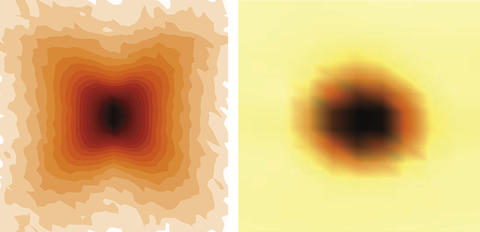
These two neutron scattering images represent the nanoscale structures of single crystals of PMN and PZT. Because the atoms in PMN deviate slightly from their ideal positions, diffuse scattering results in a distinctive butterfly shape quite different from that of PZT, in which the atoms are more regularly spaced.
Piezoelectrics—materials that can change mechanical stress to electricity and back again—are everywhere in modern life. Computer hard drives. Loud speakers. Medical ultrasound. Sonar. Though piezoelectrics are a widely used technology, there are major gaps in our understanding of how they work. Now researchers at the National Institute of Standards and Technology (NIST) and Canada's Simon Fraser University believe they've learned why one of the main classes of these materials, known as relaxors, behaves in distinctly different ways from the rest and exhibit the largest piezoelectric effect. And the discovery comes in the shape of a butterfly.
The team examined two of the most commonly used piezoelectric compounds—the ferroelectric PZT and the relaxor PMN—which look very similar on a microscopic scale. Both are crystalline materials composed of cube-shaped unit cells (the basic building blocks of all crystals) that contain one lead atom and three oxygen atoms. The essential difference is found at the centers of the cells: in PZT these are randomly occupied by either one zirconium atom or one titanium atom, both of which have the same electric charge, but in PMN one finds either niobium or manganese, which have very different electric charges. The differently charged atoms produce strong electric fields that vary randomly from one unit cell to another in PMN and other relaxors, a situation absent in PZT.
"PMN-based relaxors and ferroelectric PZT have been known for decades, but it has been difficult to identify conclusively the origin of the behavioral differences between them because it has been impossible to grow sufficiently large single crystals of PZT," says the NIST Center for Neutron Research (NCNR)'s Peter Gehring. "We've wanted a fundamental explanation of why relaxors exhibit the greatest piezoelectric effect for a long time because this would help guide efforts to optimize this technologically valuable property."
A few years ago, scientists from Simon Fraser University found a way to make crystals of PZT large enough that PZT and PMN crystals could be examined with a single tool for the first time, permitting the first apples-to-apples comparison of relaxors and ferroelectrics. That tool was the NCNR's neutron beams, which revealed new details about where the atoms in the unit cells were located. In PZT, the atoms sat more or less right where they were expected, but in the PMN, their locations deviated from their expected positions—a finding Gehring says could explain the essentials of relaxor behavior.
"The neutron beams scatter off the PMN crystals in a shape that resembles a butterfly," Gehring says. "It gives a characteristic blurriness that reveals the nanoscale structure that exists in PMN—and in all other relaxors studied with this method as well—but does not exist in PZT. It's our belief that this butterfly-shaped scattering might be a characteristic signature of relaxors."
Additional tests the team performed showed that PMN-based relaxors are over 100 percent more sensitive to mechanical stimulation compared to PZT, another first-time measurement. Gehring says he hopes the findings will help materials scientists do more to optimize the behavior of piezoelectrics generally.
D. Phelan, C. Stock, J.A. Rodriguez-Rivera, S. Chi, J.Leão, X. Long,Y. Xie, A.A. Bokov, Z. Ye, P. Ganesh and P.M. Gehring. Role of random electric fields in relaxors. Proceedings of the National Academy of Sciences, Jan. 21, 2014. DOI:10.1073/pnas.1314780111.

